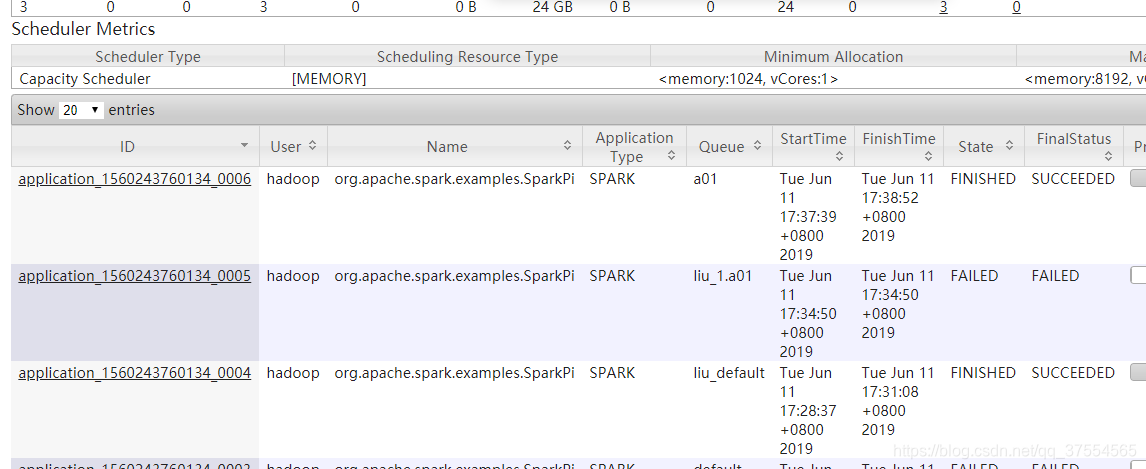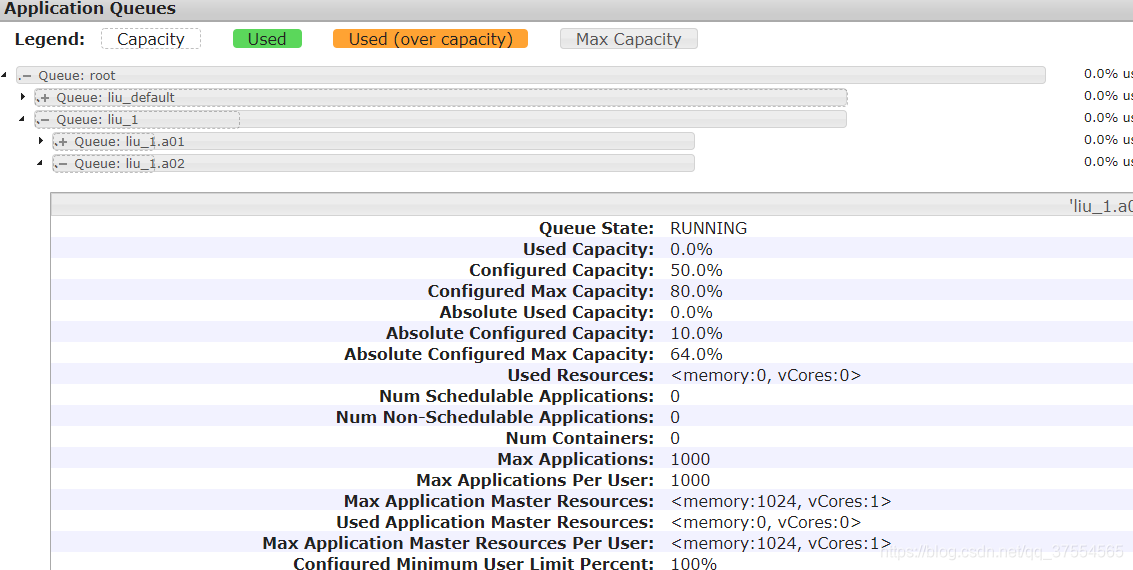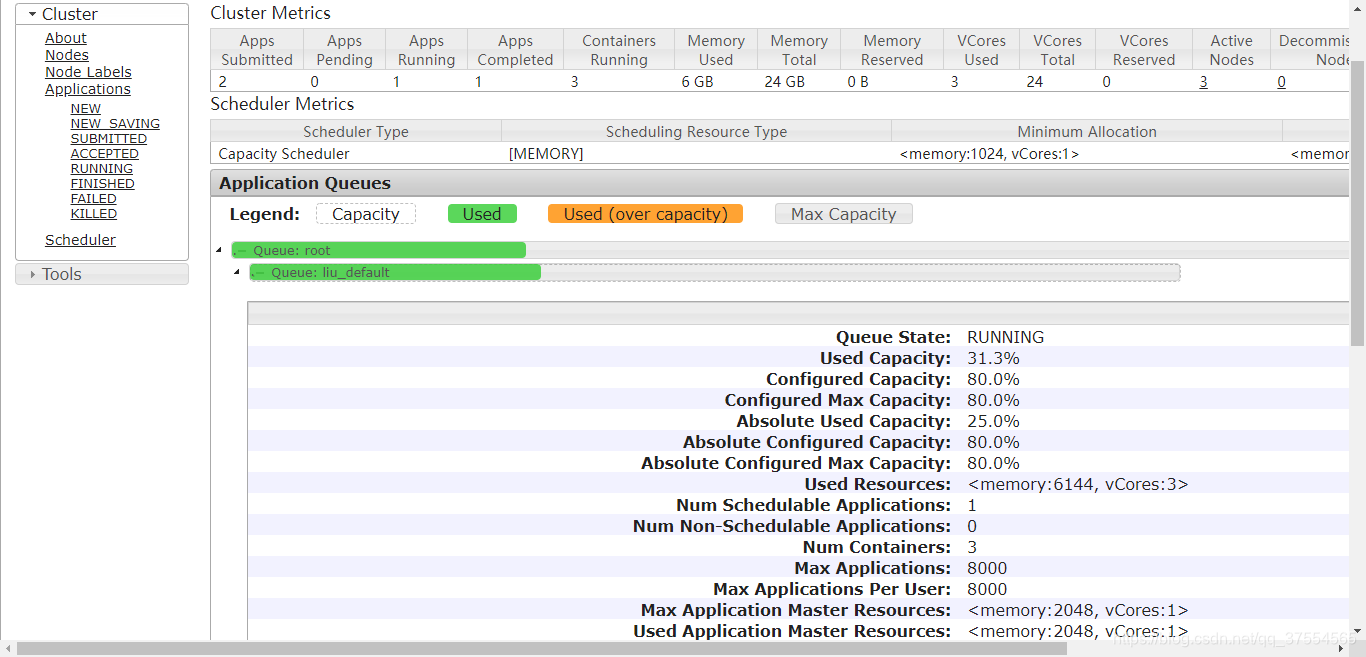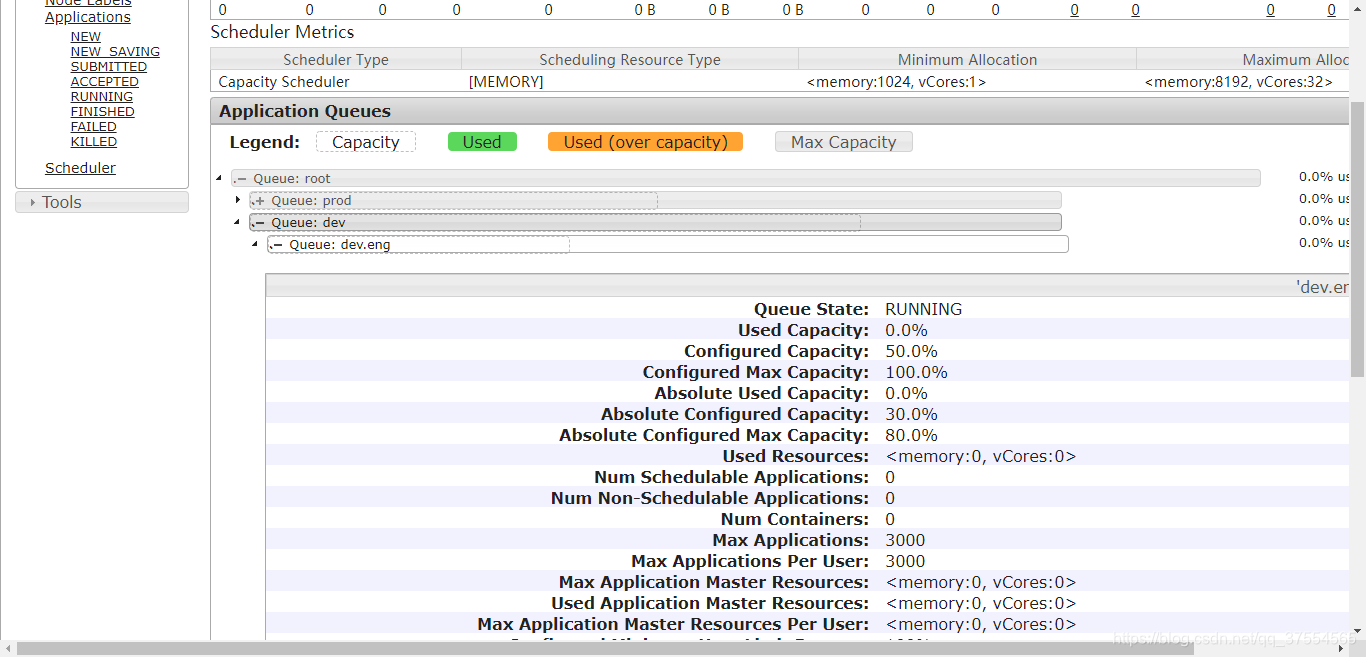yarn的资源队列配置
一、目标配置
root
------liu_default[20%]
------liu_1[80%]
|---liu_1.a01[50%]
|---liu_1.a02[50%]


二、配置两个文件yarn-site.xml 和 capacity-scheduler.xml
yarn-site.xml
<property>
<name>yarn.resourcemanager.scheduler.class</name>
<value>org.apache.hadoop.yarn.server.resourcemanager.scheduler.capacity.CapacityScheduler</value>
</property>
capacity-scheduler.xml
<!--
Licensed under the Apache License, Version 2.0 (the "License");
you may not use this file except in compliance with the License.
You may obtain a copy of the License at
http://www.apache.org/licenses/LICENSE-2.0
Unless required by applicable law or agreed to in writing, software
distributed under the License is distributed on an "AS IS" BASIS,
WITHOUT WARRANTIES OR CONDITIONS OF ANY KIND, either express or implied.
See the License for the specific language governing permissions and
limitations under the License. See accompanying LICENSE file.
-->
<configuration>
<property>
<name>yarn.scheduler.capacity.maximum-applications</name>
<value>10000</value>
<description>
Maximum number of applications that can be pending and running.
</description>
</property>
<property>
<name>yarn.scheduler.capacity.maximum-am-resource-percent</name>
<value>0.1</value>
<description>
Maximum percent of resources in the cluster which can be used to run
application masters i.e. controls number of concurrent running
applications.
</description>
</property>
<property>
<name>yarn.scheduler.capacity.resource-calculator</name>
<value>org.apache.hadoop.yarn.util.resource.DefaultResourceCalculator</value>
<description>
The ResourceCalculator implementation to be used to compare
Resources in the scheduler.
The default i.e. DefaultResourceCalculator only uses Memory while
DominantResourceCalculator uses dominant-resource to compare
multi-dimensional resources such as Memory, CPU etc.
</description>
</property>
<property>
<name>yarn.scheduler.capacity.root.queues</name>
<value>liu_default,liu_1</value>
<description>
The queues at the this level (root is the root queue).
</description>
</property>
<property>
<name>yarn.scheduler.capacity.root.liu_default.capacity</name>
<value>20</value>
<description>Default queue target capacity.</description>
</property>
<property>
<name>yarn.scheduler.capacity.root.liu_default.user-limit-factor</name>
<value>1</value>
<description>
Default queue user limit a percentage from 0.0 to 1.0.
</description>
</property>
<property>
<name>yarn.scheduler.capacity.root.liu_default.maximum-capacity</name>
<value>80</value>
<description>
The maximum capacity of the default queue.
</description>
</property>
<property>
<name>yarn.scheduler.capacity.root.liu_default.state</name>
<value>RUNNING</value>
<description>
The state of the default queue. State can be one of RUNNING or STOPPED.
</description>
</property>
<property>
<name>yarn.scheduler.capacity.root.liu_default.acl_submit_applications</name>
<value>*</value>
<description>
The ACL of who can submit jobs to the default queue.
</description>
</property>
<property>
<name>yarn.scheduler.capacity.root.liu_default.acl_administer_queue</name>
<value>*</value>
<description>
The ACL of who can administer jobs on the default queue.
</description>
</property>
<property>
<name>yarn.scheduler.capacity.root.liu_1.capacity</name>
<value>80</value>
<description>Default queue target capacity.</description>
</property>
<property>
<name>yarn.scheduler.capacity.root.liu_1.user-limit-factor</name>
<value>1</value>
<description>Default queue user limit a percentage from 0.0 to 1.0.</description>
</property>
<property>
<name>yarn.scheduler.capacity.root.liu_1.maximum-capacity</name>
<value>80</value>
<description>The maximum capacity of the default queue.</description>
</property>
<property>
<name>yarn.scheduler.capacity.root.liu_1.state</name>
<value>RUNNING</value>
<description>The state of the default queue. State can be one of RUNNING or STOPPED.</description>
</property>
<property>
<name>yarn.scheduler.capacity.root.liu_1.acl_submit_applications</name>
<value>*</value>
<description>The ACL of who can submit jobs to the default queue.</description>
</property>
<property>
<name>yarn.scheduler.capacity.root.liu_1.acl_administer_queue</name>
<value>*</value>
<description>The ACL of who can administer jobs on the default queue.</description>
</property>
<!-- liu_1 -->
<property>
<name>yarn.scheduler.capacity.root.liu_1.queues</name>
<value>a01,a02</value>
<description>
The queues at the this level (root is the root queue).
</description>
</property>
<!-- a01-->
<property>
<name>yarn.scheduler.capacity.root.liu_1.a01.capacity</name>
<value>50</value>
<description>Default queue target capacity.</description>
</property>
<property>
<name>yarn.scheduler.capacity.root.liu_1.a01.user-limit-factor</name>
<value>1</value>
<description>Default queue user limit a percentage from 0.0 to 1.0.</description>
</property>
<property>
<name>yarn.scheduler.capacity.root.liu_1.a01.maximum-capacity</name>
<value>80</value>
<description>The maximum capacity of the default queue.</description>
</property>
<property>
<name>yarn.scheduler.capacity.root.liu_1.a01.state</name>
<value>RUNNING</value>
<description>The state of the default queue. State can be one of RUNNING or STOPPED.</description>
</property>
<property>
<name>yarn.scheduler.capacity.root.liu_1.a01.acl_submit_applications</name>
<value>*</value>
<description>The ACL of who can submit jobs to the default queue.</description>
</property>
<property>
<name>yarn.scheduler.capacity.root.liu_1.a01.acl_administer_queue</name>
<value>*</value>
<description>The ACL of who can administer jobs on the default queue.</description>
</property>
<!-- a02-->
<property>
<name>yarn.scheduler.capacity.root.liu_1.a02.capacity</name>
<value>50</value>
<description>Default queue target capacity.</description>
</property>
<property>
<name>yarn.scheduler.capacity.root.liu_1.a02.user-limit-factor</name>
<value>1</value>
<description>Default queue user limit a percentage from 0.0 to 1.0.</description>
</property>
<property>
<name>yarn.scheduler.capacity.root.liu_1.a02.maximum-capacity</name>
<value>80</value>
<description>The maximum capacity of the default queue.</description>
</property>
<property>
<name>yarn.scheduler.capacity.root.liu_1.a02.state</name>
<value>RUNNING</value>
<description>The state of the default queue. State can be one of RUNNING or STOPPED.</description>
</property>
<property>
<name>yarn.scheduler.capacity.root.liu_1.a02.acl_submit_applications</name>
<value>*</value>
<description>The ACL of who can submit jobs to the default queue.</description>
</property>
<property>
<name>yarn.scheduler.capacity.root.liu_1.a02.acl_administer_queue</name>
<value>*</value>
<description>The ACL of who can administer jobs on the default queue.</description>
</property>
<property>
<name>yarn.scheduler.capacity.node-locality-delay</name>
<value>40</value>
<description>
Number of missed scheduling opportunities after which the CapacityScheduler
attempts to schedule rack-local containers.
Typically this should be set to number of nodes in the cluster, By default is setting
approximately number of nodes in one rack which is 40.
</description>
</property>
<property>
<name>yarn.scheduler.capacity.queue-mappings</name>
<value></value>
<description>
A list of mappings that will be used to assign jobs to queues
The syntax for this list is [u|g]:[name]:[queue_name][,next mapping]*
Typically this list will be used to map users to queues,
for example, u:%user:%user maps all users to queues with the same name
as the user.
</description>
</property>
<property>
<name>yarn.scheduler.capacity.queue-mappings-override.enable</name>
<value>false</value>
<description>
If a queue mapping is present, will it override the value specified
by the user? This can be used by administrators to place jobs in queues
that are different than the one specified by the user.
The default is false.
</description>
</property>
</configuration>
重启 yarn
stop-yarn.sh #停止
start-yarn.sh #启动
三、提交spark程序到指定的yarn上
spark-submit --master yarn-cluster --queue liu_default --class org.apache.spark.examples.SparkPi examples/jars/spark-examples_2.11-2.4.0.jar 1

四、附上hadoop权威指南配置的方法
capacity-scheduler.xml
<!--
Licensed under the Apache License, Version 2.0 (the "License");
you may not use this file except in compliance with the License.
You may obtain a copy of the License at
http://www.apache.org/licenses/LICENSE-2.0
Unless required by applicable law or agreed to in writing, software
distributed under the License is distributed on an "AS IS" BASIS,
WITHOUT WARRANTIES OR CONDITIONS OF ANY KIND, either express or implied.
See the License for the specific language governing permissions and
limitations under the License. See accompanying LICENSE file.
-->
<configuration>
<property>
<name>yarn.scheduler.capacity.maximum-applications</name>
<value>10000</value>
<description>
Maximum number of applications that can be pending and running.
</description>
</property>
<property>
<name>yarn.scheduler.capacity.maximum-am-resource-percent</name>
<value>0.1</value>
<description>
Maximum percent of resources in the cluster which can be used to run
application masters i.e. controls number of concurrent running
applications.
</description>
</property>
<property>
<name>yarn.scheduler.capacity.resource-calculator</name>
<value>org.apache.hadoop.yarn.util.resource.DefaultResourceCalculator</value>
<description>
The ResourceCalculator implementation to be used to compare
Resources in the scheduler.
The default i.e. DefaultResourceCalculator only uses Memory while
DominantResourceCalculator uses dominant-resource to compare
multi-dimensional resources such as Memory, CPU etc.
</description>
</property>
<property>
<name>yarn.scheduler.capacity.root.queues</name>
<value>prod,dev</value>
<description>
The queues at the this level (root is the root queue).
</description>
</property>
<property>
<name>yarn.scheduler.capacity.root.dev.queues</name>
<value>eng,science</value>
</property>
<property>
<name>yarn.scheduler.capacity.root.prod.capacity</name>
<value>40</value>
<description>prod queue target capacity.</description>
</property>
<property>
<name>yarn.scheduler.capacity.root.dev.capacity</name>
<value>60</value>
<description>prod queue target capacity.</description>
</property>
<!-- prod -->
<property>
<name>yarn.scheduler.capacity.root.prod.user-limit-factor</name>
<value>1</value>
<description>
prod queue user limit a percentage from 0.0 to 1.0.
</description>
</property>
<property>
<name>yarn.scheduler.capacity.root.prod.maximum-capacity</name>
<value>80</value>
<description>
The maximum capacity of the prod queue.
</description>
</property>
<property>
<name>yarn.scheduler.capacity.root.prod.state</name>
<value>RUNNING</value>
<description>
The state of the default queue. State can be one of RUNNING or STOPPED.
</description>
</property>
<property>
<name>yarn.scheduler.capacity.root.prod.acl_submit_applications</name>
<value>*</value>
<description>
The ACL of who can submit jobs to the default queue.
</description>
</property>
<property>
<name>yarn.scheduler.capacity.root.prod.acl_administer_queue</name>
<value>*</value>
<description>
The ACL of who can administer jobs on the default queue.
</description>
</property>
<!-- dev -->
<property>
<name>yarn.scheduler.capacity.root.dev.user-limit-factor</name>
<value>1</value>
<description>
dev queue user limit a percentage from 0.0 to 1.0.
</description>
</property>
<property>
<name>yarn.scheduler.capacity.root.dev.maximum-capacity</name>
<value>80</value>
<description>
The maximum capacity of the dev queue.
</description>
</property>
<property>
<name>yarn.scheduler.capacity.root.dev.state</name>
<value>RUNNING</value>
<description>
The state of the default queue. State can be one of RUNNING or STOPPED.
</description>
</property>
<property>
<name>yarn.scheduler.capacity.root.dev.acl_submit_applications</name>
<value>*</value>
<description>
The ACL of who can submit jobs to the default queue.
</description>
</property>
<property>
<name>yarn.scheduler.capacity.root.dev.acl_administer_queue</name>
<value>*</value>
<description>
The ACL of who can administer jobs on the default queue.
</description>
</property>
<property>
<name>yarn.scheduler.capacity.root.dev.eng.capacity</name>
<value>50</value>
</property>
<property>
<name>yarn.scheduler.capacity.root.dev.science.capacity</name>
<value>50</value>
</property>
<property>
<name>yarn.scheduler.capacity.root.liu_1.acl_submit_applications</name>
<value>*</value>
<description>The ACL of who can submit jobs to the default queue.</description>
</property>
<property>
<name>yarn.scheduler.capacity.root.liu_1.acl_administer_queue</name>
<value>*</value>
<description>The ACL of who can administer jobs on the default queue.</description>
</property>
<property>
<name>yarn.scheduler.capacity.node-locality-delay</name>
<value>40</value>
<description>
Number of missed scheduling opportunities after which the CapacityScheduler
attempts to schedule rack-local containers.
Typically this should be set to number of nodes in the cluster, By default is setting
approximately number of nodes in one rack which is 40.
</description>
</property>
<property>
<name>yarn.scheduler.capacity.queue-mappings</name>
<value></value>
<description>
A list of mappings that will be used to assign jobs to queues
The syntax for this list is [u|g]:[name]:[queue_name][,next mapping]*
Typically this list will be used to map users to queues,
for example, u:%user:%user maps all users to queues with the same name
as the user.
</description>
</property>
<property>
<name>yarn.scheduler.capacity.queue-mappings-override.enable</name>
<value>false</value>
<description>
If a queue mapping is present, will it override the value specified
by the user? This can be used by administrators to place jobs in queues
that are different than the one specified by the user.
The default is false.
</description>
</property>
</configuration>









 本文详细介绍了如何配置YARN的资源队列,包括设置队列层级、分配资源比例和权限控制。通过实例展示了如何在yarn-site.xml和capacity-scheduler.xml中进行具体配置,以及如何提交Spark程序到指定的YARN队列。
本文详细介绍了如何配置YARN的资源队列,包括设置队列层级、分配资源比例和权限控制。通过实例展示了如何在yarn-site.xml和capacity-scheduler.xml中进行具体配置,以及如何提交Spark程序到指定的YARN队列。
















 2482
2482

 被折叠的 条评论
为什么被折叠?
被折叠的 条评论
为什么被折叠?








